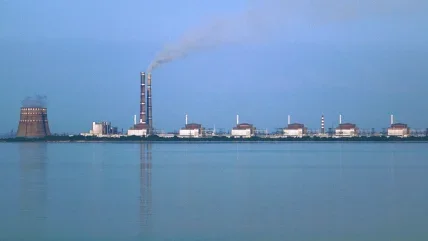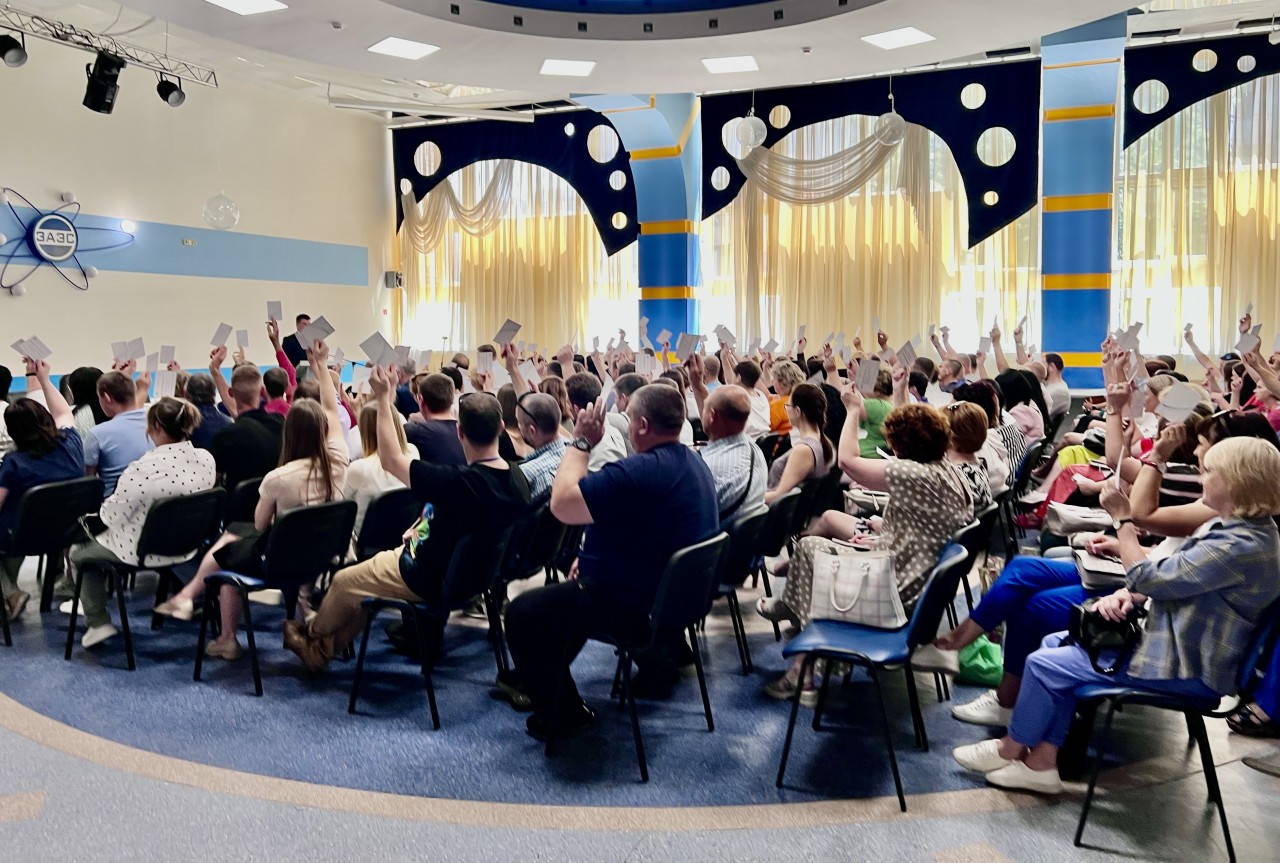
Despite continued accusations from Ukraine that Russia is planning to “blow up” the Zaporizhia NPP (ZNPP), the International Atomic Energy Agency (IAEA) says its experts at the site “have so far found no visible indications of mines or other explosives”.
The IAEA said its experts were able to inspect parts of the plant’s cooling system, including some sections of the perimeter of the large cooling pond and the isolation gate of the discharge channel of the nearby Zaporizhia Thermal Power Plant (ZTPP). It noted that both this channel and the cooling pond “hold reserves of water that remain available for use by the ZNPP despite the destruction of the downstream Kakhovka dam more than three weeks ago”.
The IAEA experts have also been conducting regular walkdowns across the six reactor units and other areas around the site. Access to further areas is still expected, including parts of the turbine halls and some parts of the cooling system. “As previously indicated, the IAEA is aware of reports that mines and other explosives have been placed in and around the ZNPP, including mines near the cooling pond.”
IAEA Director General Rafael Mariano Grossi said such reports are taken very seriously IAEA experts at the site had been instructed to look into the matter and request necessary access. “Until now they have not observed any mines or other explosives. Further access will still be needed.”
The five basic principles for the protection of Europe’s largest nuclear power plant (NPP) that Director General Grossi established on 30 May at the United Nations Security Council state that there should be no attack from or against the plant and that it should not be used as storage or a base for heavy weapons – multiple rocket launchers, artillery systems and munitions, and tanks.
“We need full access to be able to confirm that the five principles have not been violated, and we will continue to request the necessary access to all those areas essential to nuclear safety and security so that we can deliver on this mandate, including that the plant should not be used as storage or base for heavy weapons and munitions,” Grossi said. We are reinforcing our own presence at the plant to monitor compliance with these principles that are of paramount importance for protecting the plant and preventing a major nuclear accident during the war.”
IAEA said that since the Kakhovka dam was breached on 6 June, causing a rapid drop in water levels at the plant’s reservoir, ZNPP has been relying on separate reserves of water held near or at the site, especially the ZTPP’s discharge channel. Currently, the plant’s six reactors continue to be cooled using the essential cooling system, now being replenished with underground water pumped from the site’s drainage system, Grossi explained. For other water needs, the plant has recently switched from using the ZTPP discharge channel to the large cooling pond next to the site.
As a result, the height of the ZNPP cooling pond is declining by up to 1 centimetre a day, but water from the drainage system is also being used to replenish the pond, slowing the fall in the water level which is currently just over 16.5 metres.
On 23 June the ZNPP had started the normal circulation pumps to take water from the ZTPP’s inlet channel, which used to be directly connected to the reservoir but has since been detached from it. However, this had to stop because the water level was too low for operating these pumps. Instead, Grossi said, the plant is preparing to use smaller submersible pumps to access water from this inlet channel and refill the ZTPP discharge channel the water level in the channel had been falling by around 10 centimetres a day until the plant started using the cooling pond. It has now stabilised at just under 17 metres, helped by recent rain and cooler weather.
Pumping additional water into the discharge channel would provide an extra buffer for the ZNPP. To help preserve these existing but still finite resources the plant has also reduced as much as possible consumption of water not needed for essential nuclear safety and security functions. “Even though the site currently has sufficient water reserves for some months, the plant needs to act now to ensure sufficient water for the longer term. The plant is working to address this issue, but it is a complex undertaking,” Grossi said.
Five of ZNPP’s six reactors are in cold shutdown. Unit 5 remains in hot shutdown to generate steam required for the site. The IAEA experts visited the Unit 5 main control room yesterday and confirmed the hot shutdown status. The experts have also been informed that the plant is still assessing the need for steam to determine what type of external steam generator could be installed and possibly allow the cold shutdown of Unit 5. The IAEA is also aware that the Ukraine regulator has made changes to the licences of some of the units of ZNPP, including that the operation of Unit 5 be carried out in a cold shutdown state.
Since Russia took control of ZNPP in March 2022 as part of its special military operation in Ukraine, the Russian national guard, Rosgvardiya, has been protecting the station. In October, Russian President Vladimir Putin signed a decree formally transferring ZNPP to Russian jurisdiction under nuclear utility Rosenergoatom (part of Rosatom). A Russian Federal State Unitary Enterprise. Zaporizhia NPP was established by Rosenergoatom to operate the plant. However, Ukrainian nuclear utility Energoatom still claims ownership of the plant.
Reports by Russian military analysts have continued to suggest that retaking control of ZNPP is one of the main objectives of the Ukrainian counter-offensive. There have been four unsuccessful attempts by Ukrainian forces to storm the plant since September 2022. Russia and Ukraine have blamed each other for shelling that has repeatedly downed power lines vital to cooling the reactors, which are shut down but which need a constant supply of electricity to keep the nuclear fuel inside cool and prevent a possible meltdown. Russia and Ukraine have also accused each other of destroying the Nova Kakhovka dam.
In a further update, IAEA said ZNPP had been reconnected to its only available back-up power line four months after it was lost, but warned that the site’s power situation remains extremely fragile during the ongoing military conflict and is not sustainable.
The ZNPP’s connection to the single remaining 330 kilovolt (kV) power line – one of six such back-up lines which functioned before the conflict – was cut on 1 March due to damage sustained on the other side of the Dnipro River and finally restored in the evening of 1 July. Work to reconnect the power line had been hampered by the difficult security situation in the region.
IAEA said reconnection of the 330 kV line is significant as the ZNPP had been relying on a single main 750 kV line for the external electricity it needs for reactor cooling and other essential nuclear safety and security functions. It had four 750 kV lines before the conflict began in February 2022.
The 330 kV line is now energised and is kept as back-up and ready to supply power to the ZNPP if the 750 kV line becomes unavailable or damaged. ZNPP has so far lost all off-site power seven times, forcing it to temporarily resort to the site’s emergency diesel generators for electricity.
Meanwhile, Ukraine has continued to accuse Russia of planning some kind of “provocation” at ZNPP. On 29-30 June Ukraine held large-scale special exercises “in the event of a possible terrorist attack”. These were coordinated by Energy Minister Herman Galushchenko, Minister of Internal Affairs Ihor Klymenko State Emergency Service head Serhiy Kruk, Energoatom President Petro Kotin, and the head of the State Inspectorate for Nuclear Regulation, Oleg Korikov, as well as regional and military leaders.
“During the exercises, various scenarios of a possible accident at the station and the impact of this event on the surrounding areas were simulated, said Galushchenko. The training exercises involved the public notification system, traffic monitoring and radiation monitoring and evacuation of the population by road and rail transport. Galushchenko emphasised that in the event of an accident, the population should only follow the recommendations of official representatives of the authorities.
Simultaneously the press service of Ukraine’s Main Intelligence Directorate of the Ministry of Defence alleged in a statement that personnel were being evacuated from ZNPP. It said Ukrainian employees who had signed a contract with Rosatom had been advised to evacuate and to leave by 5 July for Crimea.
In response, the adviser to the General Director of Rosenergoatom, Renat Karchaa told Rossiya 24 TV: “In fact, this is either another attack of schizophrenia, or another planned lie within the framework of the scenario that the Ukrainian regime fabricating. Of course not – no one gave instructions about any departures.” He added that ZNPP was operating normally. “We did not give any such instructions to our employees. No one is going anywhere.”
Karchaa said the station now employs almost 4,000 people. “some periodically leave for the weekend, some go on planned vacations.”
He added that the misinformation was intended to create an “alternative virtual reality” in preparation for some kind of false flag operation for which Russia would be blamed. “It is quite obvious that they are preparing some kind of special operation aimed at a nuclear incident,” he said.
Vladimir Rogov, a member of the Main Council of the [Russian] regional administration of Zaporozhye, told Izvestia that Ukraine constantly threatens relatives of ZNPP employees. “Everything is normal at ZNPP. Russian specialists and other people are at their jobs, and continue to work despite blackmail and threats, as well as all sorts of threats.” These are aimed “not so much at people who work at ZNPP and who have signed contracts with Rosenergoatom, but at their relatives”, he said. He explained that many employees have relatives in territories controlled by Ukraine. “And regularly they are told that their relatives will be detained or put in jail because they are considered a traitor…. There are hundreds of cases of this kind. People share this with us, but we can’t help them, because these people are under the control of the Zelensky regime, and we can’t influence this.”
Above: Trade Union meeting at ZNPP (courtesy of Rosatom)
Nevertheless, ZNPP reported that currently, three months after its creation, 2,500 people have now joined the plant’s trade union. This is more than 70% of the entire staff. Recently a meeting was held to elect union officials. The ZNPP press service explained that the condition for holding such a meeting was that 50% of the paid employees should be members. At the meeting, the work of the trade union was explained, its organisation was decided and a committee was established. Natalya Butorina was unanimously elected chairman. “We have a lot of work ahead of us. A trade union is a public organisation that, according to the legislation of the Russian Federation, has the right and is able to represent the interests and protect the rights of workers,” she said. “We will do our best to realise all the aspirations and needs of our team.”






